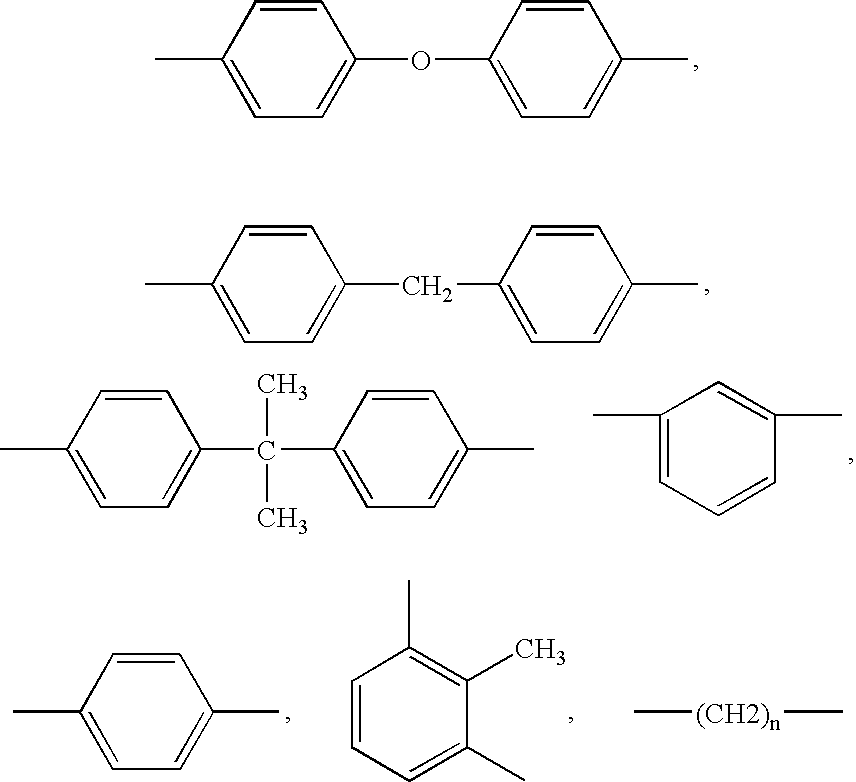Polyester film for heat-resistant capacitor, metallized film thereof, and heat-resistant film capacitor containing the same
a technology of polyethylene film and capacitor, which is applied in the field of polyethylene film, can solve the problems of capacitors having low capacitor properties, capacitors with low capacitor properties, and equipment safety hazards,
- Summary
- Abstract
- Description
- Claims
- Application Information
AI Technical Summary
Benefits of technology
Problems solved by technology
Method used
Image
Examples
examples
[0110]The present invention will now be described below with reference to representative examples and comparative examples.
example 10
[0118]The PET chips used in Example 1 in preparing the blended chips of PEI and PET were thermally crystallized at 180° C. and then treated (solid phase-condensed) for 14 hours at a temperature of 230° C. and at a vacuum degree of 100 Pa to prepare PET chips with an inherent viscosity of 0.85. Blended chips were prepared from the resulting PET chips together with PEI, and film formation was effected in the same manner as used in Example 3 except that the stretching conditions were changed as shown in Table 1. Thus, a biaxially oriented polyester film with a thickness of 3.5 μm was obtained. The results obtained from this film as evaluated are shown in Tables 1 and 2. Although the glass transition temperature of this film was nearly comparable to that of Example 3, the insulation breakdown voltage at 125° C. was higher than that of Example 3. The resulting capacitor was excellent in charging life compared to that of Example 3.
example 11 and comparable examples 5 to 7
[0119]Dimethyl naphthalene-2,6-dicarboxylate and ethylene glycol were subjected to conventional ester interchange in the presence of manganese acetate, followed by addition of trimethyl phosphate. To this end, the amounts of manganese acetate and trimethyl phosphate to be added were adjusted to set each of manganese and phosphorus at a mol of 45 ppm. Upon subsequent addition of 0.02% by weight of antimony trioxide, conventional polycondensation was effected to obtain polyethylene-2,6-naphthalate (PEN) with an inherent viscosity of 0.62 (a melt temperature of 263° C.).
[0120]Subsequently, 50 parts by weight of PEN with an inherent viscosity of 0.62 obtained here and 50 parts by weight of polyether imide, “Ultem” 1010 manufactured by GE Plastics Co., were dehumidified and dried at 150° C. for 5 hours, and the mixture was supplied into a vent-type twin-screw extruder (L / D=40) provided with a screw of a two-screw three-thread type (a dissolving zone of a finely dispersed phase obtained t...
PUM
| Property | Measurement | Unit |
|---|---|---|
| Ra | aaaaa | aaaaa |
| elongation at break | aaaaa | aaaaa |
| glass transition temperature | aaaaa | aaaaa |
Abstract
Description
Claims
Application Information
 Login to View More
Login to View More - Generate Ideas
- Intellectual Property
- Life Sciences
- Materials
- Tech Scout
- Unparalleled Data Quality
- Higher Quality Content
- 60% Fewer Hallucinations
Browse by: Latest US Patents, China's latest patents, Technical Efficacy Thesaurus, Application Domain, Technology Topic, Popular Technical Reports.
© 2025 PatSnap. All rights reserved.Legal|Privacy policy|Modern Slavery Act Transparency Statement|Sitemap|About US| Contact US: help@patsnap.com



